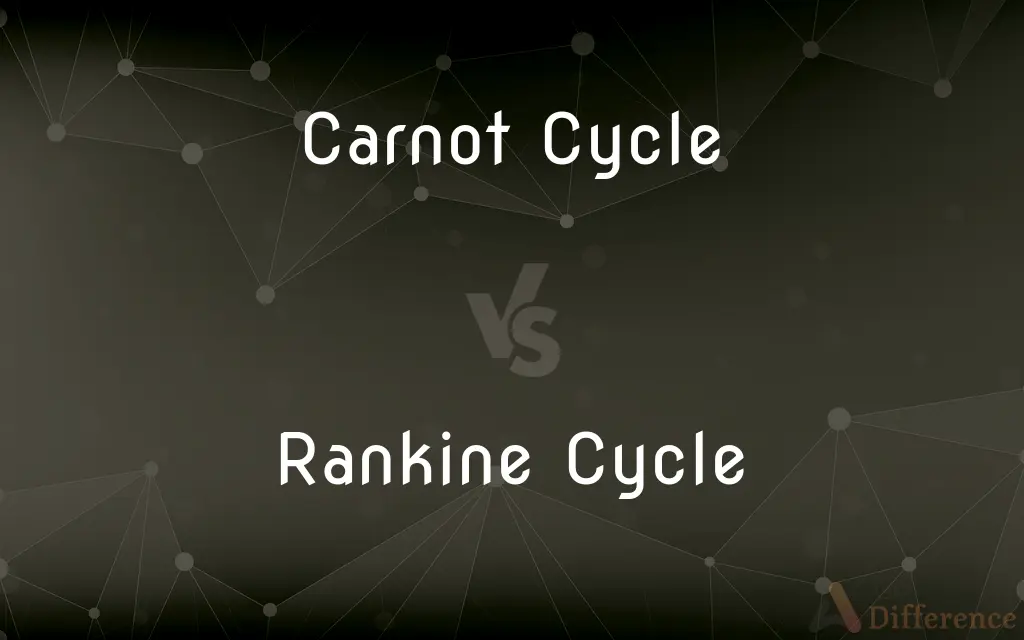Carnot Cycle vs. Rankine Cycle — What's the Difference?
Edited by Tayyaba Rehman — By Fiza Rafique — Published on December 20, 2023
Carnot Cycle is an idealized thermodynamic cycle with maximum efficiency, while the Rankine Cycle is a practical cycle used mainly in steam power plants.

Difference Between Carnot Cycle and Rankine Cycle
Table of Contents
ADVERTISEMENT
Key Differences
Carnot Cycle and Rankine Cycle are both essential concepts in the realm of thermodynamics. The Carnot Cycle is theorized as the most efficient thermodynamic cycle possible, operating between two temperature reservoirs. It involves isothermal and adiabatic processes without any phase changes. In contrast, the Rankine Cycle, predominantly used in steam power plants, is a practical thermodynamic cycle involving phase changes between liquid and vapor.
While the Carnot Cycle establishes the upper limit for the efficiency of any engine, the Rankine Cycle exemplifies the compromises made in real-world applications. The Carnot Cycle, due to its idealized nature, isn't directly implementable in practical engines.
On the other hand, the Rankine Cycle, with its inherent phase changes, seeks to maximize efficiency within the constraints of feasible engineering designs. Both the Carnot Cycle and the Rankine Cycle underline the challenges and aspirations of engineers and scientists in the perpetual quest for greater energy efficiency.
Comparison Chart
Nature
Theoretical/idealized
Practical
Efficiency Comparison
Represents maximum possible efficiency
Generally lower than Carnot Cycle
ADVERTISEMENT
Processes Involved
Isothermal and adiabatic processes
Includes phase changes between liquid and vapor
Implementation
Not directly implementable in real-world engines
Commonly used in steam power plants
Working Substance
Can be any substance
Typically uses water or refrigerants
Compare with Definitions
Carnot Cycle
An idealized thermodynamic cycle operating between two temperature reservoirs.
The Carnot Cycle serves as a benchmark for efficiency in thermodynamic systems.
Rankine Cycle
Involves phase changes between the liquid and vapor states.
The Rankine Cycle's phase changes distinguish it from the Carnot Cycle.
Carnot Cycle
Demonstrates the principles of reversibility in thermodynamics.
The Carnot Cycle's reversible nature sets the efficiency upper bound for all engines.
Rankine Cycle
A subcritical or supercritical cycle based on the fluid's state.
Advancements in the Rankine Cycle have led to supercritical steam power plants.
Carnot Cycle
A theoretical cycle not directly implementable in real-world engines.
While the Carnot Cycle is ideal, real-world engines can't achieve its efficiency.
Rankine Cycle
Often utilizes water or refrigerants as the working substance.
Water's properties make it ideal for the Rankine Cycle in steam turbines.
Carnot Cycle
Represents the maximum efficiency attainable by an engine.
Engineers refer to the Carnot Cycle to understand potential efficiency limits.
Rankine Cycle
Seeks to maximize efficiency within real-world constraints.
Engineers have modified the Rankine Cycle to suit various real-world applications.
Carnot Cycle
Comprises isothermal and adiabatic processes without phase changes.
The simplicity of the Carnot Cycle makes it a fundamental study in thermodynamics.
Rankine Cycle
A practical thermodynamic cycle used predominantly in steam power plants.
Modern power plants optimize the Rankine Cycle for electricity generation.
Common Curiosities
How does the efficiency of the Rankine Cycle compare to the Carnot Cycle?
The Rankine Cycle's efficiency is generally lower than the maximum efficiency represented by the Carnot Cycle.
Does the Carnot Cycle involve phase changes?
No, the Carnot Cycle comprises isothermal and adiabatic processes without phase changes.
Can the Carnot Cycle be implemented in real-world engines?
No, the Carnot Cycle is theoretical and serves as an efficiency benchmark.
How does the Carnot Cycle set efficiency limits?
It represents the maximum possible efficiency attainable between two temperature reservoirs.
What's the primary distinction between the Carnot Cycle and the Rankine Cycle?
The Carnot Cycle is an idealized, maximum efficiency cycle, whereas the Rankine Cycle is a practical cycle used mainly in steam power plants.
Where is the Rankine Cycle predominantly used?
The Rankine Cycle is chiefly used in steam power plants for electricity generation.
Why is the Carnot Cycle considered reversible?
The processes in the Carnot Cycle can be reversed, making it a model for reversible thermodynamic cycles.
Are there modifications to the Rankine Cycle for enhanced efficiency?
Yes, there are variations like the supercritical Rankine Cycle for improved performance.
Can any substance be used in the Carnot Cycle?
Theoretically, yes. The Carnot Cycle principles can apply to any substance.
What working substance is typically used in the Rankine Cycle?
The Rankine Cycle predominantly uses water or refrigerants.
How do phase changes in the Rankine Cycle impact its operation?
Phase changes, especially boiling and condensation, play a crucial role in energy conversion in the Rankine Cycle.
Are there engines that come close to the Carnot Cycle's efficiency?
While no real-world engine can reach the Carnot Cycle's efficiency, advancements seek to approach this theoretical limit.
Do both cycles operate between two temperature limits?
Yes, both the Carnot and Rankine Cycles operate between a high and a low temperature.
Can the Rankine Cycle operate beyond the critical point of water?
Yes, in supercritical Rankine Cycles, the working fluid operates beyond its critical point.
What's the significance of the Carnot Cycle in thermodynamics?
It sets the theoretical upper limit for efficiency, serving as a benchmark.
Share Your Discovery

Previous Comparison
F1 vs. Grand Prix
Next Comparison
Apology vs. ForgivenessAuthor Spotlight
Written by
Fiza RafiqueFiza Rafique is a skilled content writer at AskDifference.com, where she meticulously refines and enhances written pieces. Drawing from her vast editorial expertise, Fiza ensures clarity, accuracy, and precision in every article. Passionate about language, she continually seeks to elevate the quality of content for readers worldwide.
Edited by
Tayyaba RehmanTayyaba Rehman is a distinguished writer, currently serving as a primary contributor to askdifference.com. As a researcher in semantics and etymology, Tayyaba's passion for the complexity of languages and their distinctions has found a perfect home on the platform. Tayyaba delves into the intricacies of language, distinguishing between commonly confused words and phrases, thereby providing clarity for readers worldwide.
















































